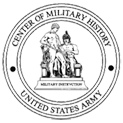
- Home
- Artwork and Photography
- Army Artwork
- Prints and Posters
- The American Soldier: Set 1
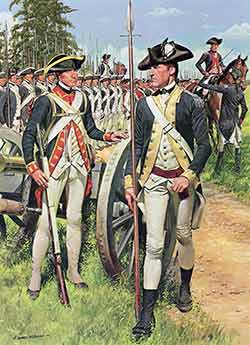
The American Soldier, 1781
The troops in this painting wear the uniforms prescribed in the regulations of 1779 and supplied at the time of the Yorktown campaign -- blue coats with distinctive facings for the infantry regiments from four groups of states: New England; New York and New Jersey; Pennsylvania, Delaware, Maryland, and Virginia; and the Carolinas and Georgia. All of the infantry coats were lined with white and had white buttons. All troops wore white overalls and waistcoats.
+ Click here to expandA lieutenant in the right foreground is recognizable by the epaulette on his left shoulder. He is in the uniform worn by the troops from New York and New Jersey, blue faced with buff. On his cocked hat he wears the black and white "Union" cockade introduced by General Washington in July 1780, emblematic of the union of the American and French Armies. He holds an espontoon, the weapon carried by all company officers and sergeants in addition to their swords.
To the left of the lieutenant stands a private of artillery in the blue coat faced with red and lined with red, trimmed with yellow of the artillery.
In the background, from left to right, are the New England troops from New Hampshire, Massachusetts, Rhode Island, and Connecticut in blue faced with white, and a drummer in the reversed colors (behind the espontoon). Then come musicians in red faced with blue, the reversed colors of the units from Pennsylvania, Delaware, Maryland, and Virginia. At the far right are two field officers from these same states in blue coats faced with red, with epaulettes on both shoulders; the one on horseback wears a gorget,an officer's insignia worn in most European armies of the period.
- Click here to close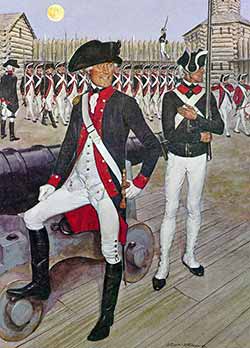
The American Soldier, 1786
The whole U.S. Army in the fall of 1784 was one infantry regiment; consisting of eight infantry and two artillery companies. Four states -- Connecticut, New York, New Jersey, and Pennsylvania -- were called upon to furnish the troops, but only two, New Jersey and Pennsylvania, responded, The missions of the Army were to occupy the forts along the frontier and protect the U.S. commissioners making treaties with the Indians.
+ Click here to expandThe uniform, adopted by the Secretary of War and approved by General Washington in General Orders in December 1782, consisted of a blue coat with red facing, white lining and buttons for the infantry, and red lining and yellow buttons for the artillery.
In the left foreground is a captain of artillery, an epaulette on his right shoulder, wearing the red lined coat with yellow buttons.
In the right foreground is an infantry private in the fatigue vest made of blue cloth with a red collar used for daily duties to spare the uniform coats. Sometimes the fatigue vests were made by company tailors (as in the one shown); sometimes they were merely last year's coats cut down, in which case they might retain the red cuffs.
In the background is a field grade officer, distinguished by his silver epaulettes, inspecting a detachment of infantrymen in blue coats faced with red and lined with white. The infantrymen are headed by their musicians in reversed colors -- red coats with blue facings. The Army of 1784 was not always able to furnish uniforms even for the small number of troops in the service. The New Jersey detachment in 1784, for example, was issued some blue coats with white facings, the old uniform of the New England line. The detachment's captain was forced to stop the men's rum ration in order to use the money to buy red cloth so that the company tailor could make all the coats uniform.
- Click here to close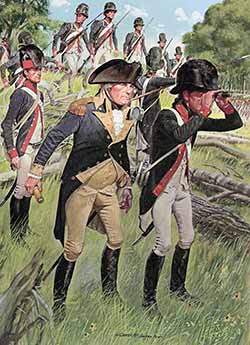
The American Soldier, 1794
The Army that on 20 August 1794 at the Battle of Fallen Timbers avenged the defeats suffered at the hands of the Indians in 1790 and 1791 was the creation of Major General Anthony Wayne. General Wayne insisted on rigid discipline and strict training. Conscious of the welfare of his men, he saw to it that supplies were adequate and equipment satisfactory. The Army at this time was reorganized into a "legion," a term widely used during the eighteenth century to mean a composite organization of all combat arms under one command.
+ Click here to expandThe Army, instead of being composed of regiments, was made up of four sub-legions, each commanded by a brigadier general and each consisting of two infantry battalions, one battalion of riflemen, one troop of dragoons, and one company of artillery. To develop esprit die corps, Wayne had each sub-legion wear distinctive insignia.
General Wayne, in the left foreground, is wearing the general officer's uniform of blue coat faced and lined with buff, and buff vest and breeches established during the Revolutionary War. He has the two silver stars of a mayor general on his gold epaulettes. To the left rear of the general is a dragoon orderly in his bearskin crested leather cap with a red turban, denoting that he is a member of the second sub-legion. The orderly's blue uniform coat faced with red and lined with white and white vest and breeches were established for all the cavalry and infantry in 1782. In the right foreground is an infantry subaltern, distinguished by an epaulette on his left shoulder and his unbound bearskin crested hat; the colors of his uniform are the same as that of the dragoon. In the background men of the First Sub-Legion, distinguishable by the white binding and black bearskin crests on their hats, advance, led by a captain armed with an espontoon.
- Click here to close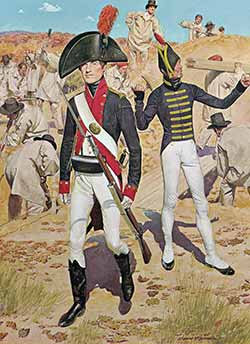
The American Soldier, 1805
Before 1805, the Army had few trained technicians, particularly in the field of engineering, and had depended largely upon foreign experts. To remedy this situation, the engineers were separated from the artillery and the Corps of Engineers, consisting of 10 artillery and engineer cadets and 7 engineer officers, was created in 1802. The Corps was to be stationed at West Point and was to constitute the Military Academy. In 1803, 19 enlisted men were added to the Corps,"to aid in making experiments and for other purposes."
+ Click here to expandIn the left foreground of the scene showing construction work near West Point in 1805 is an artillery cadet in the mixture of commissioned and noncommissioned uniforms prescribed for cadets of artillery. His blue coat is faced and lined with red, and has yellow buttons and wings piped with red-the coat worn by artillery noncoms. On his left shoulder he wears the small epaulette ordered for cadets. His officer's cocked hat bears the black nationalcockade with an eagle button and the red plume of the artillery; with his enlisted man's white linen summer overalls, he is wearing officer's half-boots.
On the right is an engineer private in the blue coat with black velvet collar and cuffs and false yellow buttonholes on the collar, cuffs, and breast adopted for the enlisted men of that Corps in 1803. He is wearing white winter overalls and an artilleryman's cocked hat with a red plume since the cap or shako could not be procured until a year later.
In the background enlisted infantrymen are working clad in the "coarse linen frock and fatigue trousers" allowed by Congress as a part of the annual clothing allowance in March 1802. For protection from the weather, old issue hats, bandanas or anything else that took the wearer's fancy was used as a headdress.
- Click here to close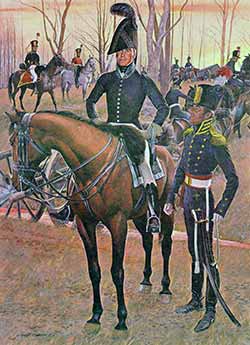
The American Soldier, 1812
The Regiment of Light Artillery, an elite horse artillery corps,was organized in 1808 in response to President Jefferson's request for an augmentation of the Army in the face of hostile British and French acts against the United States,and by l812 ranked first among the combat units in the Army. The regiment retained its position of eminence until it was disbanded in 1821. Because of the growth of the Army during the War of 1812 several staff departments were organized to serve the troops in the field, the Hospital Department being one. The department was equal to that in any other army of its day and rendered valuable services during the course of the war.
+ Click here to expandThe figure on foot in the right foreground shows a sergeant of light artillery in the all blue uniform trimmed with yellow prescribed in January 1812, when the light artillery became the first corps of the Army to do away with colored facings. The rank is recognizable by the two yellow silk epaulettes ant red sash. The sergeant wears a yeoman crowned shako -- a shako wider at the top than at the bottom -- with yellow cords, a yellow plate, and a red and white plume peculiar to the light artillery at this time.
To the left in the background is a captain of light artillery in a blue coat with white breeches,with one gold epaulette on his right shoulder and three bars in the corner of his red, gold-laced, saddle cloth. To his left is a trumpeter of light artillery in a coat of red, the reversed color of the regimental uniform.
The horseman in the foreground is an infantry surgeon in the uniform adopted in January 1812. He is recognizable by the silver embroidered collar on his plain blue coat, the lack of epaulettes, and the black ostrich feather in his black bordered hat.
Behind the infantry surgeon and partially obscured by him is a gun with its mounted crew preceded by a caisson.
- Click here to close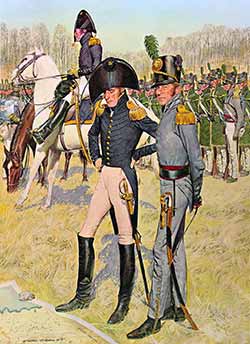
The American Soldier, 1814
The War of 1812 was the cradle of the Army's general staff. Staff departments and staff procedures comparable to the best available in European armies were developed.
A general staff officer stands in the left foreground in the singlebreasted blue coat with black herringbone false buttonholes on chest and cuffs and gold bullet buttons.
+ Click here to expandThe uniform was adopted in 1813 and worn for the next two decades. Behind him is a mounted general officer, whose saddle with its bearskin covered pistol holsters rests on a blue saddlecloth with a wide gold lace border ordered for general and staff officers. Both men wear the high military boots allowed only to general and general staff officers.
An old American institution, the rifle regiment, reappeared on the rolls of the Army in the years leading up to the War of 1812. So well liked was this type of unit that three more regiments of riflemen were created during the war.
In the right foreground is a rifle regiment field grade officer in the gray dress uniform adopted for those regiments in March 1814 and later also worn by the 26th Infantry Regiment; the officer's shako is of the same shape worn by the light artillery; with the distinctive round rifle capplate and the green rifle plume.
A detachment of riflemen in their fringed, green summer linen rifle frocks, the only reminder of the green uniform formerly worn by the rifle regiment, are seen in the background. They are flanked by a rifle sergeant in a gray dress coatee with yellow epaulettes and a red sash of his grade and by a company musician, known by the black collar and cuffs on his gray coatee, who has a bugle instead of the fife or drum carried by the musicians of the rest of the foot troops.
- Click here to close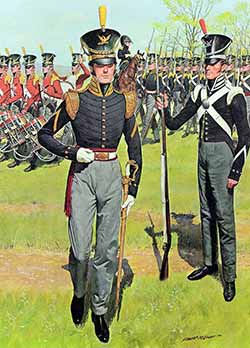
The American Soldier, 1827
The need for continued development and research in the military arts in time of peace was well recognized by the Army in the period following the War of 1812. To partially meet this need, Secretary of War John C. Calhoun proposed "a school of practice," and in 1824 the Artillery School of Practice at Fort Monroe, Virginia, was established. Unlike modern service schools, which first instruct individuals, the Artillery School began by instructing an entire unit at one time, the unit being stationed at Fort Monroe for a year's tour of duty.
+ Click here to expandIn the center foreground is a captain of artillery, his branch designated by the gold trimmings on his coat and the yellow pompon on his bell-crowned shako; like all company officers,he wears metal wings on his shoulders and a red sash; his rank is indicated by the gold chevrons on each arm above the elbow. Designation of rank by chevrons for company grade officers became necessary when wings were added to the uniform in 1821, thus making the previous designation of rank by epaulettes impossible.
To the right stands an infantry grenadier company sergeant, in blue coat with white laced collar, white wings, and buttons introduced in 1821. His grade is shown by the white chevron on each arm below the elbow. The red pompon on his shako marks him as a grenadier. Beginning in 1825,each infantry regiment was to include a grenadier and a light infantry or riflecompany on the basis of the new tactics issued to the Army that year; they were retained in the regimental organization until sometime in the 1830's.
In the background a detachment of Artillery School troops are drilling,headed by company musicians in red coats with yellow wings and the national coat of arms on their drums.
- Click here to close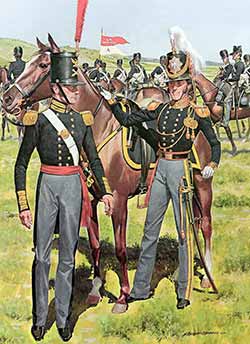
The American Soldier, 1836
As the western frontier moved across the Mississippi River in the 1820's, it became apparent that cavalry would be needed to control the mounted Plains Indians. To meet this need, a battalion of mounted rangers was organized in 1832 for one year's service. This experiment was followed in 1833 by the creation of the United States Regiment of Dragoons, today the 1st Cavalry. A second dragoon regiment was added in 1836, today the 2nd Armored Cavalry.
+ Click here to expandIn the right foreground stands a subaltern of the First Regiment of Dragoons in a blue coat with a yellow collar hidden by gold lace, yellow cuffs and turnbacks,and light blue trousers with yellow stripes. The drooping white horsehair plume indicates he is a troop officer, and the two buttons on the gold lace slashflaps on the cuffs show his rank of second lieutenant. In the background, the dragoons going out on patrol are dressed in their distinctive dark blue jackets trimmed with yellow lace and wear their collapsible leather forage caps. They are headed by their red and white guidon to which the word "Dragoons" was added by order of Secretary of War Lewis Cass in 1833.
In the left foreground is an ordnance sergeant -- of which there was one on every Army post to care for the arms, ammunition, and other military stores -- in his plain blue coat and light blue trousers with a dark blue stripe down the side. His grade is indicated by the four buttons on the yellow slashflaps on the cuffs,the heavy yellow worsted braid on his epaulettes, and his red sash.
- Click here to close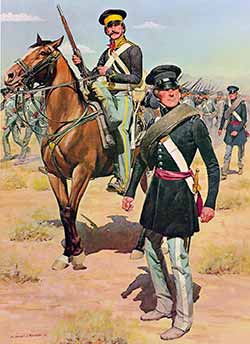
The American Soldier, 1847
The War with Mexico soon saw the major part of the small Regular Army making its way through deserts and tropical forests far from home. Well trained and led,the Regular Army units bore more than their share of fighting from Palo Alto to the city of Mexico.
+ Click here to expandThe horseman in the foreground of this painting of a column of General Zachary Taylor's troops on the march in northern Mexico is a dragoon. The yellow band on his forage cap, in contradiction to regulations, was worn by many of the cavalrymen. His distinctive dark blue fatigue jacket laced with yellow is the same as that adopted in 1833. Beside the dragoon is a first lieutenant of infantry in the dark blue frock coat worn by most officers in this campaign. The lieutenant is wearing the regulation dark blue, waterproof, cloth forage cap, and his rank is indicated by the single silver bar on his shoulderstrap to distinguish him from the second lieutenants, who wore no insignia on their shoulders/raps at this time. The light blue trousers with a white stripe down the side and the silver buttons on his coat proclaim his arm. In the background is a column of infantrymen in light blue fatigue jackets and trousers. These, with the dark blue forage cap, were the universal dress of the regular enlisted infantryman in this war.
- Click here to close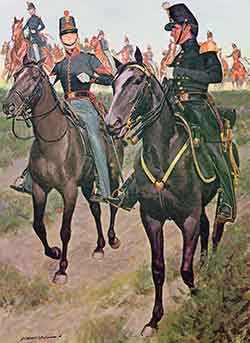
The American Soldier, 1855
Experience in the Seminole and Mexican Wars had demonstrated that campaigns in the swamps, forests, prairies, and lonely highlands of North America had to be waged in undress or fatigue uniforms. After the Mexican War many Army officers felt that the full dress uniform adopted in the early 1830's and retained without modifications was too expensive, complicated, and old-fashioned and requested a change. Their requests were heeded, and in 1851 radical changes were made in the style of the dress uniform.
+ Click here to expandThe uniform coat with sloping skirts and turnbacks worn since 1810 was replaced by a frock coat, and the tall, stiff dress cap by a cloth "gig" cap; also, some of the arms lost their established distinguishing colors. The infantry received light blue for the white worn since the Revolution, the dragoons orange instead of yellow, while the mounted rifles, over their strong protests, were given green to replace their black and gold.
In the scene depicting a battery of light artillery in 1855, a first sergeant of the light artillery is shown in the left foreground in the new jacket issued for the mounted troops in 1854, with the red piping denoting the light artillery. His grade is indicated by the three bars and lozenge of red worsted on his sleeve and by the red sergeant's sash. The red pompon on his cap and the red stripe at the base of the crown show his arm -- artillery -- and the letter on his cap, his battery.
In the right foreground is a quartermaster officer in the blue frock coat prescribed in 1851 for all officers.The buff welting on his trousers and the ornament on the front of his cap (U.S.) identify him as a general staff officer, and his pompon-- the lower two-thirds buff and the upper third light or Saxony blue -- indicates he is an officer of the Quartermaster Corps.
In the background is a battery of light artillery.
- Click here to close
<< back to Prints and Posters Series
